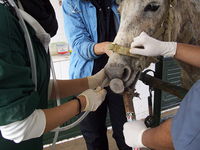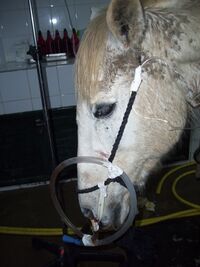Nasogastric intubation in the horse
| This article has been peer reviewed but is awaiting expert review. If you would like to help with this, please see more information about expert reviewing. |
Passing a nasogastric tube (NGT) is an important therapeutic and diagnostic technique for any patient with abdominal pain. It should be performed in any patient with abdominal pain. It has three functions. Firstly it is used to determine if there is excessive fluid in the proximal gastrointestinal tract (stomach and small intestine). If this is the case, the tube can act to remove this fluid and relieve the visceral pain associated with the distended stomach. This will prevent a fatal spontaneous rupture of the stomach. Secondly, the NGT can be used to remove esophageal obstructions in cases of choke. Thirdly, the NGT can be used therapeutically to administer large volumes of fluids, electrolytes and oral medications.
Equipment
- Appropriate-sized nasogastric tube
- Lubricant
- Bucket half-filled with warm water
- 400 ml nylon dose syringe
Procedure
The horse should be adequately restrained in stocks or in the stable. The veterinarian may need a twitch or chemical restraint. The NGT should be immersed in the bucket of warm water to make it clean and flexible. Some veterinarians may lubricate the end of the NGT for a smoother, atraumatic passage. The veterinarian should stand on the horses left and place the right hand over the nose. The veterinarian's right thumb can be used to reflect the alar fold of the left nostril, without obstructing the airflow to the right nostril. The NGT is introduced ventrally into the ventral nasal meatus. The tube is advanced slowly and the veterinarian should not use force if there is resistance. Once the tube is at the level of the epiglottis in the pharynx, there may be some resistance. Most horses swallow the tube immediately, but if this is not the case then the veterinarian should carefully bump the epiglottis with the tube or blow down the tube. The tube may need to be rotated 180 degrees to pass down the esophagus.
It is very important to check that the tube is in the esophagus and not in the trachea. The tube is visible passing down the left neckline when it is in the esophagus. It is not visible if it is in the trachea. There is negative pressure in the esophagus when suction is applied to the tube. There is no negative pressure in the trachea during suction. If the tube is in the esophagus, there should be some resistance its passage. There is no resistance when the tube is advanced down the trachea and the tracheal rings are palpable.
Once at the cardia, the veterinarian must blow into the tube to enter the stomach. There is a characteristic smell in the tube of ingesta and blowing on the tube will cause a bubbling noise. These are key to ensure that the tube is in the stomach.
To obtain reflux, the tube must become a siphon by creating a complete tube of water from the stomach to the end of the tube. This is achieved by filling the tube with warm water using the syringe, and then aspirating a bit of the fluid. The gastric fluid can be encouraged to flow out at a faster rate by quickly pulling the tube out by 10 to 15 cm. Gastric reflux should be collected into a separate bucket so that the volume can be measured and a sample is available for analysis. The tube may need to be left in place in certain conditions whereby more gastric fluid will be produced. This can be achieved by coiling the tube and taping it to the headcollar with zinc oxide tape. The horse should have the gastric fluid repeatedly removed to prevent rupture of the stomach.
If no reflux is obtained then the medications may be administered. It is important that any oral fluids or medications are warmed to body temperature prior to administration. Ensure that all of the fluids in the tube are in the stomach before removing it. Crimp the tube prior to its removal to ensure that no fluid is deposited in the pharynx.
A normal horse will have less than 2 litres of reflux.
Complications
Haemmorhage
The mucosa of the nasal conchae are extremely vascular. They are easily damaged by large tubes or traumatic passage of the tube, especially if the horse shakes its head during the introduction of the tube into the ventral meatus. Almost all bleeds will eventually stop and so the tube should be cleaned and introduced into the other nostril. If the nosebleed exceeds 10 to 15 minutes and is continuously running then it is considered to be excessive. This can be treated by using a nasal catheter to infuse 10mg phenylpehrine in 10 ml of sterile saline solution. A smaller diameter tube may be less traumatic in some cases.
Accidental aspiration
If the tube has been accidentally placed in the trachea then the administration of large volumes of fluids and medications can be fatal. It is therefore very important to check the location of the tube prior to this, mentioned above.
References
- Edwards B. (2009), Diagnosis and Pathophysiology of Intestinal Obstruction, in Equine Gastroenterology courtesy of the University of Liverpool, pp 8-9
- Meuller E, Moore J. N, (2008) Classification and Pathophysiology of Colic, Gastrointestinal Emergencies and Other Causes of Colic, in Equine Emergencies- Treatments and Procedures, 3rd Edition, Eds Orsini J. A, Divers T.J, Saunders Elsevier, pp 101-102
- Rose R.J, Hodgson D.R (2000) Examination of the Alimentary Tract, Alimentary Tract, Manual of Equine Practice, 2nd Edition, Saunders Elsevier, pp 283-285

